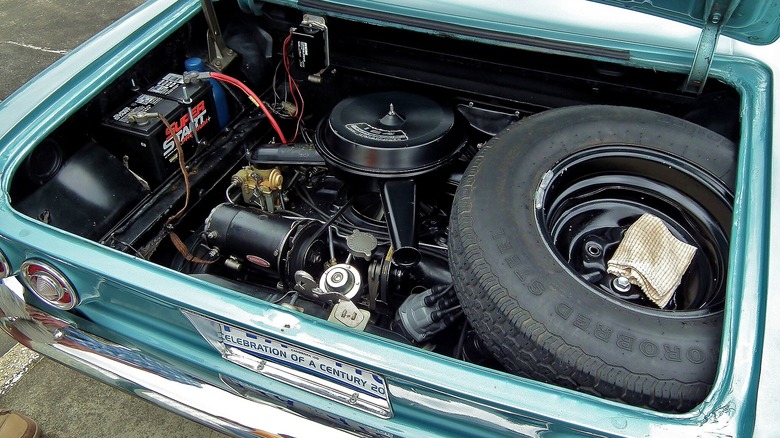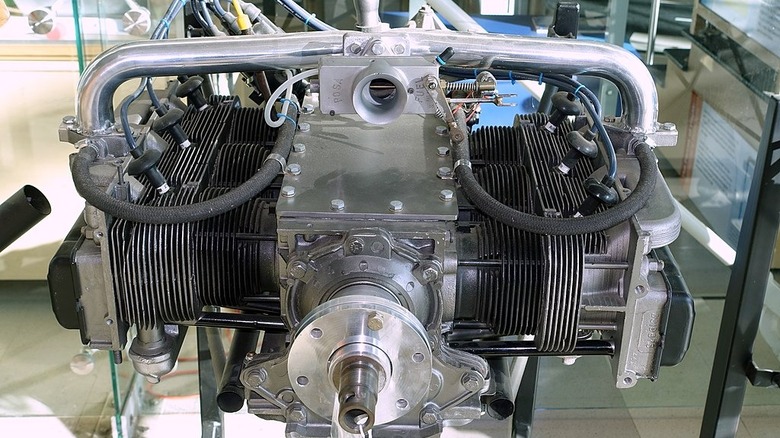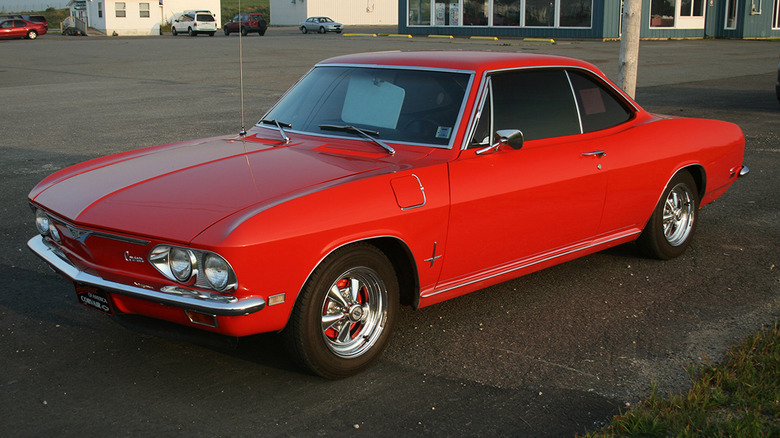Here's What Makes Chevrolet's Turbo-Air 6 Engine So Interesting
To many, Chevrolet's Corvair will always be remembered as the focus of a book by a young lawyer named Ralph Nader. Unfortunately, the book's title was "Unsafe at Any Speed." In spite of a questionable suspension design that prompted Nader's criticism, the Corvair was a highly innovative compact car. It was America's answer to Germany's Volkswagen Beetle. An affordable machine for everyman that made efficient use of space, owing to its rear-engine layout and lack of superfluous equipment for liquid-cooling, just like the Beetle.
To this day, the Corvair remains the only mass-produced American vehicle with an engine that was both rear-mounted and air-cooled. Initially, the Corvair was offered in a litany of body styles including a 4-door sedan, 2-door coupe, convertible, station wagon, van, and even a pickup truck.
Powering the first-generation Corvair was a 140-cubic inch "Turbo-Air 6" which was a bit of a misnomer because there was no turbocharger involved. During the 1960s, Chevy had a bit of a turbo fetish. Its automatic transmission was called the Turbo-Hydramatic and its line of decidedly non-turbocharged big block V8 engines was called the "Turbo-Jet."
The Turbo-Air 6 had an aluminum block with six separate cast-iron cylinder barrels, finned for heat dissipation much like the Volkswagen. The cylinders were topped off with finned aluminum cylinder heads and each bank of three cylinders got its own Rochester carburetor. This configuration of horizontally opposed cylinders has several creative nicknames, the more common of which are flat, boxer, or pancake engine. At its debut in 1960, the Turbo-Air 6 was good for a whopping 80 horsepower.
[Featured image by sv1ambo via Wikimedia Commons | Cropped and scaled | CC BY 2.0]
It was one of the first production engines to be turbocharged
It didn't take long for potential Corvair buyers to demand more horsepower and Chevy engineers were only too happy to oblige. In 1962, the Turbo-Air 6 became a self-fulfilling prophecy when the option for a turbocharger became available. The newly turbocharged Corvair called the Spyder cranked out 150 horsepower — almost double the 80 horsepower of the original 1960 model. It also found itself in rare company, being one of only two factory-turbocharged vehicles in the world, the other being an Oldsmobile F-85 (later renamed Cutlass).
Buyers that didn't opt for the optional turbocharger received a consolation prize of larger displacement. By 1965, the naturally-aspirated engine was capable of 140 horsepower and the number of carburetors jumped from two to four to keep the thirsty engine fed. The turbocharged version was now rated at 180 horsepower, which engineers viewed as the upper limit to the engine's design. Additional horsepower would not only require re-tooling the engine block, but would present a challenge to the cooling system, or lack thereof.
As it was, air-conditioning was no longer offered on certain Corvair powerplants with emissions controls because it was thought that the extra parasitic drag of the a/c compressor would lead to an overheating situation.
[Featured image by Daderot via Wikimedia Commons | Cropped and scaled | CC0]
There were a few teething problems
As drivers started accumulate significant mileage with their Corvairs, a couple shortcomings began to surface. The first issue emanated from the engine's top-mounted cooling fan, which was driven by a complicated belt drive system involving two 90-degree turns. This caused early cars to throw fan belts from their pulleys, quickly resulting in overheating. This problem was solved by substituting a lightweight magnesium fan instead of the original steel unit, as well as installing new pulleys with deeper grooves for the fan belt to ride in.
The second Achilles heel of the Turbo-Air 6 was oil leaking from the connection point of the engine block and cylinder barrels, caused by deteriorating seals. The development of synthetic rubber, called Viton, resulted in more durable o-ring seals which could be retrofitted to older leaking motors.
In the late-1960s, Corvair sales dropped precipitately. Multiple reasons were to blame including the "Unsafe at any Speed" book and the fact that Chevrolet's then-General Manager, John DeLorean, didn't care for the car and subsequently didn't promote it with sufficient advertising. But perhaps the biggest death blow came from the popularity of the less fussy pony cars like Ford's new Mustang and later, GM's Camaro and Firebird.
Ultimately, even though a third-generation Corvair was in development, the car was killed off following the 1969 model year. Nowadays, modern technology like fuel injection and cylinder head porting make it possible for hot rodders to extract over 200 horsepower from a naturally aspirated Corvair engine — no turbo necessary.
[Featured image by Crwpitman via Wikimedia Commons | Cropped and scaled | CC BY-SA 4.0]


